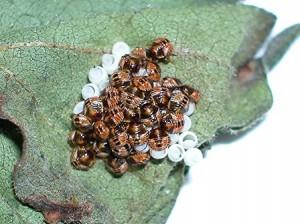Caterpillar infestations, including corn earworm, continue to be light in soybean. However, scouting late planted fields for corn earworm is a must. Concentrate your efforts on fields at R1 or R2. This will include many wheat beans. For the most part, other pest action continues to be light. But exceptions prove the rule.

Stink Bugs. I’m seeing and hearing more reports about stink bugs, primarily green stink bug. UT recommends treatment anytime a field averages 9 or more stink bugs per 25 sweeps. I’ve only laid eyes on one early maturing field at treatment level, but expect this to be more common as more of the crop approaches the R5 growth stage. Synthetic pyrethroids typically provide excellent control of green stink bugs (e.g., Baythroid XL, Karate/Warrior, Mustang Max, Declare, or one of the bifenthrin products).
Spider Mites. I’ve had several calls from across the state about spider mites in soybean. Although not a common pest, they can cause severe stress, defoliation and even plant death. There are no established treatment thresholds in soybean, but I would recommend treatment if spider mites are causing leaf yellowing or premature leaf drop. Spot or edge treatments may be possible. The many “true miticides” labeled in cotton are NOT labeled in soybean. Treatment options for soybean are limited to Brigade or one of the other bifenthrin products (5-6 oz/acre), Dimethoate 4E (12-16 oz/acre), and Lorsban Advanced or a generic equivalent (12-16 oz/acre). The good news is these products work better in soybean than cotton, at least in my limited experience, but I wish we had more choices.

